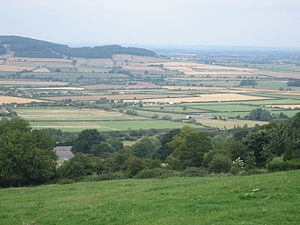
Stanley Pontlarge
Encyclopedia

Hamlet (place)
A hamlet is usually a rural settlement which is too small to be considered a village, though sometimes the word is used for a different sort of community. Historically, when a hamlet became large enough to justify building a church, it was then classified as a village...
in Gloucestershire
Gloucestershire
Gloucestershire is a county in South West England. The county comprises part of the Cotswold Hills, part of the flat fertile valley of the River Severn, and the entire Forest of Dean....
, within the civil parish of Prescott and the ecclesiastical parish of Winchcombe
Winchcombe
Winchcombe is a Cotswold town in the local authority district of Tewkesbury, in Gloucestershire, England. Its population according to the 2001 census was 4,379.-Early history:...
.



Domesday Book
Domesday Book , now held at The National Archives, Kew, Richmond upon Thames in South West London, is the record of the great survey of much of England and parts of Wales completed in 1086...
, when it was referred to
as "Stanlege".
The hamlet has a small church, whose dedication is unknown. The church was a possession of Hailes Abbey
Hailes Abbey
Hailes Abbey is two miles northeast of Winchcombe, Gloucestershire, England.The abbey was founded in 1245 or 1246 by Richard, Earl of Cornwall, called "King of the Romans" and the younger brother of King Henry III of England. He was granted the manor of Hailes by Henry, and settled it with...
before the Dissolution. The original Norman structure was heavily restored
Victorian restoration
Victorian restoration is the term commonly used to refer to the widespread and extensive refurbishment and rebuilding of Church of England churches and cathedrals that took place in England and Wales during the 19th-century reign of Queen Victoria...
by Thomas Collins in 1860-61. The chancel was rebuilt. The church is noted for its Late Norman north door, with chevron mouldings, and a Norman chancel arch, leaning outwards, also with chevron moulding. The nave roof was rebuilt in 1923-4 by Sir Philip Stott. The font is a Norman bowl, remodelled into an octagonal shape in the 14th century. Most of the furnishings in the church date to the 1860-1 restoration. By agreement among the parishioners, graves in the churchyard are not marked by headstones. A guide to the location of burials is provided within the church.

Stanley Pontlarge lies on the steep northern escarpment of the Cotswolds. The steep hillsides can appear bleak, but offer a superb view northwards to the Vale of Evesham. The Gloucestershire Warwickshire Railway
Gloucestershire Warwickshire Railway
The Gloucestershire Warwickshire Railway is a volunteer-run heritage railway on the Gloucestershire/Worcestershire/Warwickshire Borders that has reopened the closed railway line between Laverton Halt and Cheltenham Racecourse railway stations in Gloucestershire/Worcestershire., it currently...
is a prominent feature of the landscape.
A variety of ugly agricultural structures and overhead wires were removed by the Landmark Trust
Landmark Trust
The Landmark Trust is a British building conservation charity, founded in 1965 by Sir John and Lady Smith, that rescues buildings of historic interest or architectural merit and then gives them a new life by making them available for holiday rental...
in the 1970s.

Further reading
D. Verey & A. Brooks. 2002. The Buildings of England. Gloucestershire 2. London: Yale University Press.External links
- Stanley Pontlarge church (Parish Website)
- Stanley Roots -- the roots of places and people called Stanley in medieval England.

